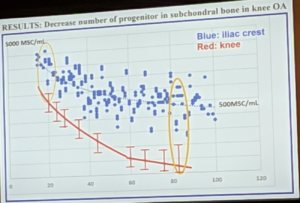What are bone marrow stem cells?
Bone marrow stem cells are blood-forming cells that regenerate the blood and immune system. They can be found in a person’s bone marrow, which is located inside the large bones of the body, such as the femur or hip. When a person has blood cancer or other diseases that affect blood cells, they may need to have their own blood replaced with new healthy blood from someone who donated bone marrow stem cells. This procedure is called a “bone marrow transplant.”
What is the purpose of a bone marrow stem cell transplant?
This treatment replaces blood cells that have been damaged or destroyed by chemotherapy or radiation therapy used for cancer patients. This process helps prevent leukemic relapse from occurring after standard treatments end since it has an ability to regenerate blood cells faster than normal methods do. It also reduces chances of infection too as patient’s own healthy immune system returns back again. In addition, this treatment does not require donor matching unlike with allogenic transplants making it much simpler and less time-consuming compared with other
What are the benefits of stem cell bone marrow transplant?
There are many benefits in blood marrow stem cell transplant. One is the improvement of blood counts and immune system function which leads to a decrease risk for infections, bleeding, organ damage etc. Another benefit is that it can treat blood cancers such as leukemia or lymphoma. The last benefit of stem cell bone marrow is that patients who undergo this treatment have less complications than those receiving an allogenic bone marrow transplant since there’s no need for perfect match between donor and patient unlike with allogenic transplants where they must match blood types perfectly.
Is blood stem cell transplant the same as bone marrow stem cell transplant?
A blood stem cell transplant is not the same as a bone marrow stem cells. A blood stromal cells are taken from your own blood and given back to you after they’ve been treated in a laboratory or with chemotherapy so that it will kill any cancer cells and only leave behind healthy blood-forming cells. Bone marrow transplants, on the other hand, involve taking out some of the patient’s own bones (usually hipbones) and putting them into storage until needed for treatment. Then these stored bones can be used to give patients new healthy blood through transfusion by replacing their damaged blood completely with new clean blood which has all its impurities removed such as toxins.
What is the age limit on a bone marrow stem cell transplant?
For a blood marrow transplant, there is no age limit. However, the patient should be in good health and must respond well to chemotherapy or radiation before they can proceed with blood stem cell transplants.
Are there any side effects for a bone marrow stem cell transplant?
Patients may experience temporary side effects like diarrhea, loss of appetite and fatigue. Others go through a period where blood cell counts are low which can make them more vulnerable to infections.
For more on stem cell therapy myths, check out our article here.
For more on stem cell therapy side effects, and if stem cell therapy is right for you, read our article here.
Do bone marrow stem cells work in the elderly?
80-year-old Georgia was suffering from back pain for many years. She also has many severe medical conditions including heart failure, pulmonary hypertension, and kidney failure. She is on dialysis.
Her MRI revealed disc degeneration, disc bulges, severe facet joint arthritis, and spinal stenosis.
She tried numerous treatments for her back pain including opioids, physical therapy, multiple epidural injections, burning off her facet joint nerves. Unfortunately, they did not help her. Because of her severe medical conditions, surgery was not an option.
She decided to get stem cell therapy. We extracted stem cells from her bone marrow and concentrated them. These cells were placed precisely into her discs, facet joints and sacroiliac joints using x-ray guidance. Below is the image of her procedure. Notice how her discs are collapsed and almost bone on bone, especially the L45 disc.

Since this procedure can be done with mild sedation and local anesthesia, in spite of her multiple medical problems, she tolerated the therapy very well.
Now she is almost pain-free.
Stem cell therapy for bone marrow isn’t the only way stem cells can improve your quality of life.
Come see our other resource pages on how stem cell therapy can help you live a pain-free life.
Stem cell therapy for knee pain
Stem cell therapy for back pain
Stem cell therapy as a knee replacement alternative
Stem cell therapy for neck pain
Stem cell therapy for herniated disc
See what Georgia has to say in the video below.
The common myth is that as we age, the number of bone marrow stem cells dramatically decline in the bone marrow. This is true for the bone marrow stem cells in the long bones. Fortunately, the stem cell numbers are much better preserved in the iliac crest bone [bone in the back of the hip] from where we obtain the cells. This is the main reason why we are seeing good results with bone marrow stem cells even in our elderly patients. Georgia is not an exception.
In fact, Georgia’s bone marrow cell numbers were very high. Her TNC [Total Nucleated Cell Count] was 1.87 billion. TNC is a surrogate marker for stem cell numbers. In one intradiscal stem cell study, the average TNC was 847 million. Georgia’s TNC was more than double of what was reported in that study. Age did not affect Georgia’s bone marrow stem cell count.
Dr.Hernigou is an orthopedic surgeon from France. He is the pioneer of stem cells for treating joint pains. He has been using bone marrow stem cells to treat pain for more than 40 years. Through his work, we now know that bone marrow stem cells are not only effective to treat pain but are also very safe. Other stem cells like fat, umbilical or amniotic stem cells do not have this long history of safety and efficacy. I borrowed a slide from one of his talks which explains why bone marrow stem cells work in the elderly.

One of his studies measured the number of stem cells as we age in both long bones and the iliac crest. The red line shows that as we get older, the number of bone marrow stem cell dramatically decline in the long bones. However, the blue line reveals that the numbers are relatively well maintained in the iliac crest where we get our stem cells from. This explains the good results that we are seeing in elderly patients.
This concept was also proven in another study. Here they analyzed the number of stem cells in the iliac crests of patients between the age of 26 and 83. Interestingly, they found a small decrease in the number of stem cells in older patients when compared to younger patients and this decrease was not significant.
We now have 2 studies that have shown that iliac crest bone marrow stem cells do not decrease with aging.
There are 2 types of bone marrow. The red marrow and yellow marrow. Red marrow is seen in younger patients. This red marrow is responsible for creating new blood cells. As we age, the red marrow becomes yellow marrow. This is because the red marrow is replaced by fatty tissue. Yellow marrow is not as efficient in producing new blood cells. However, this conversion of red marrow to yellow marrow happens only in the long bones. It does not happen in the iliac crest where bone marrow stem cells are extracted for stem cell therapy. See the picture below.
This is great news for patients because, among all the available stem cells, bone marrow stem cells are the most FDA compliant.
Since bone marrow stem cells are taken from the patient’s own body, there is no risk of allergic reactions or the risk of rejection.
Umbilical or Amniotic stem cells are obtained from other patients. This increases the risk of allergic reactions and rejection. Additionally, there is also an increase in the risk of transmission of viral and bacterial diseases from the donor. There have been reports of serious infections in patients who received umbilical stem cells.
A recent case that gathered a lot of media attention revealed that when stem cells are given from a donor, the recipient’s genetic makeup is altered. This is worrisome.
To summarise, currently, bone marrow stem cells seem to be the best for the following reasons.
- They seem to be the most FDA compliant
- They have the longest record of safety
- They have the longest record of efficacy
- They have no risk of allergic reactions or rejection
- They have no risk of genetic alteration
If you are exploring the option of stem cell therapy to treat pain, insist on getting bone marrow stem cells. If the clinic is offering umbilical or amniotic stem cells, avoid it. These procedures are unfortunately expensive as insurance does not cover them. Spend your money wisely. After all, it’s your health.













